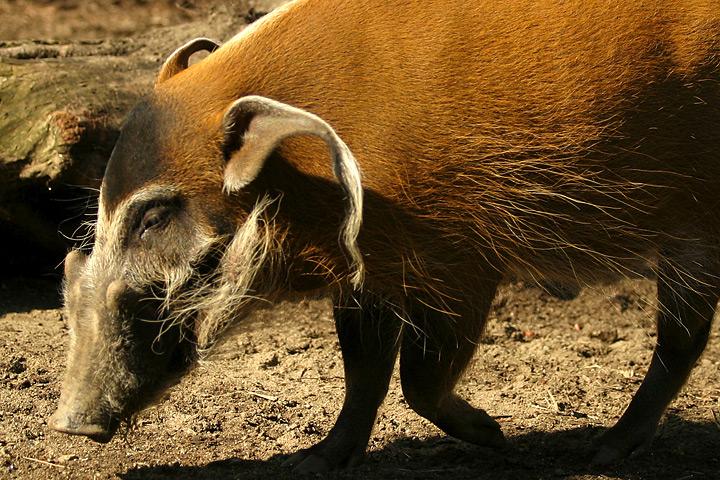- Suina
Taxobox
name = Suina

image_caption = "Potamochoerus porcus "
regnum =Animal ia
phylum = Chordata
classis =Mammal ia
ordo =Artiodactyla
subordo = Suina
subordo_authority = Gray, 1868
subdivision_ranks = Families
subdivision =Suidae
Tayassuidae
Entelodontidae †
Raoellidae †
The suborder Suina (also known as Suiformes) contains perhaps the earliest and most archaic even-toed ungulates.Fact|date=August 2008Classification
The suborder Suina includes the family
Suidae (pig s, hogs) and the familyTayassuidae (peccaries). Some morphological studies also identified the familyHippopotamidae (hippopotami) among the Suina.The
oreodonts , a branch of thetylopoda , were often considered suines due to the popular, though inaccurate, description of them as "ruminating hogs". Oreodonts are not suines, but are closer related to camels. However, the predators of the oreodonts, theentelodonts of the extinct family entelodontidae, are most likely suines. The peccaries and entelodonts seem to be closer related to each other than either is to modern pigs. In addition, as mentioned below, the Hippopotamus and the related anthracotheres may also not be suines.Status of hippopotamidae
Hippopotamus were once thought to be part of the Suina, but a growing body of morphological and genetic evidence has suggested that they share a common ancestor not with Suina, but with
Cetacean s—the Order which includeswhales anddolphins . Whales and artiodactyls form aclade calledCetartiodactyla . cite journal |last=Boisserie |first=Jean-Renaud |coauthors= Fabrice Lihoreau and Michel Brunet |year= 2005 |month= February|title= The position of Hippopotamidae within Cetartiodactyla|journal=Proceedings of the National Academy of Sciences |volume= 102 |issue= 5|pages= 1537–1541|url= http://www.pnas.org/cgi/content/full/102/5/1537|accessdate= 2007-06-09|doi= 10.1073/pnas.0409518102|pmid= 15677331]The most recent research into the origins of hippopotamidae suggests that hippos and whales shared a common semi-aquatic ancestor that branched off from other Artiodactyls around mya|60|million years ago.Cite journal | url = http://mbe.oxfordjournals.org/cgi/content/abstract/14/5/537 | title = More DNA support for a Cetacea/Hippopotamidae clade: the blood-clotting protein gene gamma-fibrinogen | author = Gatesy, J. | journal =
Molecular Biology and Evolution | volume = 14 | pages = 537–543 | pmid = 9159931] This hypothesized ancestor likely split into two branches around mya|54|million years ago.Cite journal | title = Analyses of mitochondrial genomes strongly support a hippopotamus-whale clade | volume = 265 | issue = 1412 | year = 1998 | pages = 2251 | journal =Proceedings of the Royal Society | author = Ursing,B.M. | coauthor = U. Arnason | doi = 10.1098/rspb.1998.0567] One branch would evolve into cetaceans, possibly beginning with the proto-whale "Pakicetus " from mya|52|million years ago and other early whale ancestors, known asArchaeoceti , which eventually underwentaquatic adaptation into the almost completely aquaticcetacea ns.Anatomy
The anatomy of the Suina is different compared to other
even-toed ungulates . For example, they have maxillary teeth, which allow for proper chewing of food. In contrast, other even-toed ungulates such asgoat s anddeer , have teeth only on the bottom. This doesn't let them chew very well, so they have to swallow it and regurgitate the food to allow rumination.Most even-toed ungulates have a four-chambered stomach. In contrast, the Suina have a simple stomach that allows an
omnivorous diet.Most members of Suina have toes rather than hooves. While most artiodactyls have long slender legs, the Suina generally have short, stubby legs.
ee also
*
Cetartiodactyla
*Ruminantia
*Mesonychid References
External links
* http://www.iucn.org/themes/ssc/sgs/pphsg/Contents.htm
* http://www.paleocene-mammals.de/condylarths.htm
* http://www.ultimateungulate.com/Cetartiodactyla.html
Wikimedia Foundation. 2010.
